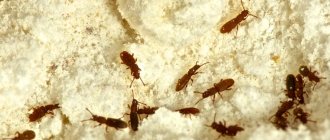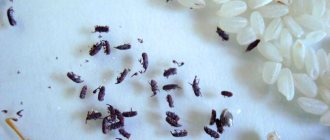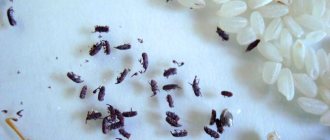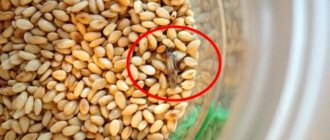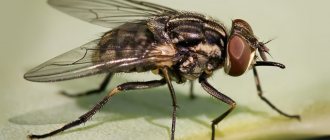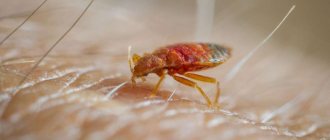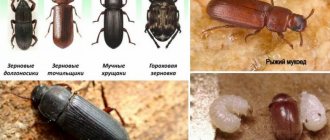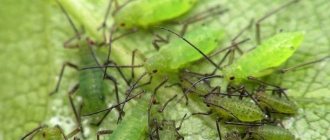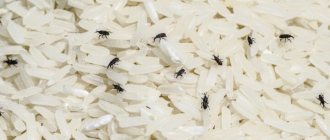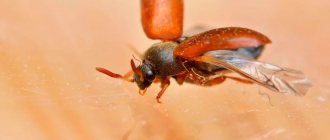Causes of insects
Where do insects come from in kitchen cabinets? Little lovers of cereals and flour live only in these products. They have nothing to eat outside, so it is impossible to bring beetles from there. They won’t fly into the window or crawl away from their neighbors because they don’t travel long distances. The only reason why bugs appear in cereals is poor quality processing by the manufacturer.
If the manufacturer of bulk products neglects the standards for the production and storage of cereals, poorly processes the goods before packaging, insect larvae end up in stores, and from there - in kitchen cabinets. Most often, insects can be found in cereals sold by weight, but sometimes they are also found in hermetically sealed packages.
As soon as even one package of contaminated product appears in the kitchen, an insect invasion soon occurs. From the larvae present in the cereal, bugs hatch, which quickly spread and multiply.
Where do bugs in cereals and larvae come from?
In most cases, the insect or its larva gets in with poor quality cereals purchased by weight. However, it is not uncommon for beetle eggs to be found in vacuum packaging, if we are talking about unscrupulous manufacturers who violate the sanitary regime for storing cereals in factories and warehouses.
Infection can occur in recently purchased cereals due to improper proximity, when prunes, pasta, flour, tea, coffee, and spices are stored nearby.
Be sure to read:
How to deal with silverfish in an apartment: TOP 10 poisons and means why they are harmful to humans
Is it dangerous to eat food contaminated with bugs?
If there are bugs in the cereal, you should not eat it. It is better to throw away all contaminated products or feed them to birds and animals. If such waste is beyond your means, the products must be thoroughly cleaned. It is better to sort the cereal by hand and sift the flour through a fine sieve.
After there are no visible insects left in the cereal, it must be thermally treated:
- Heat in the oven . Flour and semolina cannot withstand heating above 50°C. Other cereals can be heated to 100-110°C. Processing time – 30-40 minutes.
- To freeze. Place the sorted grains into bags and close them tightly. Place in the freezer for 2-3 days. In winter, you can put the cereal on the balcony or in the courtyard of a private house.
- Keep it in the sun. Spread the product in a thin layer on a baking sheet and place in direct sunlight for several hours.
If you plan to make porridge from the contaminated product right now, you can fill it with salted water. After some time, all the pests will float to the surface.
Important! Even if there are no adults in the croup, white larvae, scales, and insect waste products invisible to the eye will remain in it. To eat or not to eat such a product is rather a matter of disgust. However, it should not be given to young children, elderly people or those with weakened immune systems. Pest residue may cause an allergic reaction.
Why do rice get bugs?
Let's say right away - bugs in cereals are not a sign of unsanitary conditions in the kitchen. Even in sterile conditions they start up with enviable regularity.
If manufacturers do not comply with sanitary standards, if they do not process cereals in accordance with established rules, it will not be possible to avoid the appearance of uninvited guests.
But, even if the cereal is of the highest quality and absolutely clean, beetles can still appear in it. They come from neighboring products (tea, coffee, pasta, dried fruits, etc.) and multiply very quickly.
Pest prevention
There are many ways to get rid of bugs in cereals in the kitchen. However, this cannot be done forever. There will always be a possibility of buying a low-quality bulk product again.
To minimize the risk, preventive measures should be followed:
- Purchase products only from trusted manufacturers . Preference is given to sealed plastic packaging. Do not buy bulk cereals that appear to be of obviously poor quality.
- Buy groceries only for a short period . It's good to have supplies of essential goods. But in completely filled kitchen cabinets, there is a higher risk that bugs will fill all the packs, which then have to be thrown away.
- Use storage containers . Glass jars that close tightly for bulk products are the best option. They will not protect against the appearance of pests, but will not allow them to spread beyond the container. As a last resort, open bags should be closed with a paper clip or clothespin and tied with an elastic band.
- Conduct regular audits. Once a month, it is advisable to sort through existing food supplies and throw away what has become unusable. Something that has been lying around for a long time, but is still suitable, should be consumed first.
- Do the cleaning. Crevices and corners of cabinets clogged with crumbs and food residues are cozy places for pests. Keeping your kitchen clean is an important preventative measure.
To repel insects, you can put fabric bags and sachets with aromatic herbs and spices in the closet. Lavender, wormwood, nutmeg, and cloves are suitable.
General cleaning as a method of pest control
Pests can also be removed by thoroughly cleaning their habitat. But subject to the obligatory condition of disposal of affected products.
What do we have to do:
- Empty the cabinet or shelf of its contents. Clean everything inside with a soapy vinegar solution. Pay special attention to food residues that often spill out in storage areas.
- Pour boiling water over all containers.
- Wash fabric bags in salt water.
- For adult individuals, it is better to use special traps.
Plants with a pungent odor also show good results in the fight against insects. These include mint, lavender, lemon balm and others. Soaking cloth strips in extracts will help prevent a new insect infestation. The main thing is not to forget to update your feeds.
Types of kitchen bugs
There are several types of small bugs in the kitchen:
| Name | Peculiarities | Where does it start? |
| Bread grinder (pharmacy beetle, leather beetle) | Common type. Little brown bugs. Can fly | Flour products, pharmaceutical plants, books, tea, coffee, grain mixtures |
| Flour beetle | A small black bug with horns. Prolific. Even a sieve will not help with eggs in flour - they are too small | Flour, semolina, starch, dried fruits, bran, cereals: buckwheat, rice, oatmeal |
| Red mukoed | A red oblong bug with long horns. Enters the house with low-quality animal feed | Cereals, grain products, flour (especially old) |
| Suriname mucoed | Similar to the red mule eater, but lighter in color | Flour, grain, cereals |
| food moth | A flying insect similar to a common moth. The only kitchen pest that enters the house not only with low-quality products, but can also fly through ventilation or a window | Dried fruits, pasta, tea, cereals: buckwheat, rice, semolina, rolled oats |
| Rice weevil | An oblong bug in rice, from a distance it resembles an ant. Can fly. Breeds in warmth | Solid cereals: rice, buckwheat, pearl barley |
| Bean grain | An oval-shaped bug with a pattern on the back. Found mainly in legumes | Legumes: beans, peas, lentils, chickpeas, beans, soybeans. Can eat solid cereals |
What unites bugs in the kitchen is that they all multiply quickly and are difficult to remove.
Is it possible to eat this cereal?
If you find cereal that has bugs in it, don’t even think about whether it can be used, but throw it away immediately. Contaminated products contain the remains of chitinous shells, excrement, and various forms of insect development. Bacteria and fungi settle in such cereals and find an environment for development.
We suggest you read: Do I need to wash dried fruits and nuts before eating?
The remains of shells covered with bristles are not digested in the digestive tract of humans and can cause irritation and inflammation of the stomach. Guanine and scleroproteins that are part of tick waste are not absorbed by any organism. In grain affected by pests, uric acid is formed in large quantities, which can cause a number of diseases in humans.
If there are bugs in rice, buckwheat, oatmeal or any other cereal, do not use it. Damage to the body is not detected immediately after eating spoiled cereals. The process of undermining is hidden, cumulative and gradual. As a result of such nutrition, amino acid metabolism in the body is disrupted, the number of red blood cells and hemoglobin in the blood decreases, which leads to lethargy, weakness, and sometimes more serious consequences. Therefore, if there are bugs in the cereal, then it is better to get rid of it than to have health problems. The same applies to flour.
Theoretically, flour containing bugs can be used, but is it worth it? No matter how you sift it, there will still be excrement in it. For example, flour damaged by the Moorish booger darkens, acquires an unpleasant odor and becomes unsuitable for use in cooking. If you make dough from such flour, it will not rise well and the bread will turn out low and soggy.
People are so accustomed to cereals lying on store shelves that they buy without thinking, just by looking at the price or seeing a familiar manufacturer. However, so that you don’t have to think later about whether you can eat cereal if there are bugs in it, you should be responsible when choosing such an important product.
Knowing some subtleties you will not waste time and money in vain:
- When purchasing, be sure to look at the manufacturing date. The longer the cereal sits, the more likely it is that it will begin to deteriorate or that moths will appear in it.
- The product should not have any foreign odors, otherwise it is spoiled and by purchasing it you will not be protected from the appearance of black bugs.
- High-quality cereals contain no impurities or husks. Crushed particles in whole grains indicate improper production and the presence of pests that have already begun to “gnaw” the product.
- The cereal should not have lumps. Their presence indicates that the product was stored near water, and it gained moisture or grain moths appeared in it.
After purchase, cereals should be stored in dry containers without foreign odors with tight lids that do not allow moisture and pests to pass through. Having discovered occupants in one of the cereals, you need to check all supplies, wash, dry and ventilate kitchen cabinets.
Since you will not be able to completely get rid of bugs in flour and cereals, without a doubt, throw away the spoiled product. This is the only thing you can do in this situation if you are responsible about your health.
Black bugs and other insects in flour and cereals are a common problem. When they appear, they quickly infest everything, and a few days of delay can lead to a long time to remove the pests. They not only spoil food, but can also cause poisoning and allergic reactions.
How to get rid
Getting rid of kitchen pests is not an easy process and requires an integrated approach. The first thing to do is to find the source of the infection and get rid of it. Conduct an audit of all products. Throw away or sort out spoiled ones. Clean, wash, clean out the entire kitchen and cabinets. Then use one of the industrial or home remedies for treatment.
Folk remedies
To remove pests, the following folk remedies will help:
- Vinegar. Wash the inside of cabinets and all kitchen surfaces, including the floor, with hot water and vinegar. Treat corners and crevices especially carefully.
- Laundry soap . Dark, with a high percentage of fatty acids content is suitable. Grate and dissolve in a bucket of hot water. Use for cleaning furniture and floors.
- Borax. Mix with powdered sugar or flour. You can add raw egg, honey. Spread the mixture on flat lids or sheets of paper and place it in the beetles’ habitats. They will eat the bait and bring it with them to the colony, poisoning themselves and poisoning others.
- Vegetable oil . Place small dishes with vegetable oil in places where beetles accumulate. They will taste the oil and drown in it. The oil needs to be changed periodically.
It is believed that bugs in cereals do not like the strong smells of bay leaves, lavender, garlic, wormwood, and nutmeg. It is recommended to arrange containers and lay out bags with these products. However, there is no guarantee that odors will repel absolutely all types of bugs.
This is interesting:
How, where and for how long you can store pasta.
Is it possible to freeze kombucha and how to properly preserve it until next summer.
Secrets of proper storage of yeast dough.
Chemistry to help
Getting rid of pests using folk remedies is a rather long and labor-intensive process. This can be done much faster using special chemicals, but you need to be extremely careful with such drugs, avoid contact with skin and inhalation, and thoroughly ventilate the room.
The following remedies are effective:
- Chlorine-containing preparations (Domestos, Belizna, etc.). Wash all cabinets, shelves, walls and floors in the room with water containing chlorine. Leave all doors open and ventilate the kitchen for several hours. Repeat treatment every other day.
- "Anti-bug." Preparation for insecticidal treatment of wooden surfaces. The effect of the product is not only powerful, but also long-lasting. There is no threat of reappearance of pests for a long time.
- “DALI anti-ant” produced by Rogneda. Despite the name “anti-ant”, the drug is also effective against any insects, including bugs in flour.
- "Dichlorvos". One of the most effective remedies. Spray the kitchen with an aerosol and close it for half an hour. After this, open the windows and doors, turn on the hood and ventilate thoroughly. It is better not to stay in the treated area during the day, even after ventilation.
If folk remedies and store-bought preparations do not help remove uninvited guests from the kitchen once and for all, there is one last method. It is necessary to call a team of specialists involved in treating premises from pests. But in this case, you need to leave the apartment for a while. It is better not to enter the house for at least a day after treatment.
Important! Health and safety must be taken into account when treating your kitchen with chemicals. Remove all food products and indoor plants from the premises, and remove children and pets from the apartment during treatment. Wear gloves, long sleeves, a respirator or a medical mask. After treatment, thoroughly ventilate the room.
How are shelves treated after insect poisoning?
After getting rid of the beetles that spoil flour, cereals and vegetables, you need to start general cleaning in the kitchen. All cabinets, shelves, floors and walls should be thoroughly washed. The eggs could have been laid anywhere, so you need to pay attention to every corner. It is worth stocking up on detergent, vinegar or disinfectant solution, a washcloth and a dry cloth.
It is recommended to start cleaning from the cabinets, since beetles bred mainly in this place. You need to wash it inside and out using kitchen detergent. The disinfectant solution will help eliminate insect eggs. If you wish, you can use a safe method - hot water and vinegar.
To completely kill the beetles, disinfection must be carried out two or three times. If you used a product with a chemical composition to get rid of insects, you should not put food in the cupboard for two days.
Recycling is a simple and reliable method
When there is neither the desire nor the ability to fight the increasing population of harmful insects in bulk products in the kitchen, it is worth moving on to a radical method - recycling damaged cereals.
Packages, sacks, containers with bugs are carefully packed in sealed cellophane and taken out of the house.
Places where contaminated products were stored (shelves, cabinets, mezzanines) are thoroughly treated with soda, vinegar or chlorine solution, followed by rinsing with clean water.
Note to housewives
To avoid having to fight parasites, it is advisable to insure yourself against their occurrence in advance. In order not to rack your brains over how to remove them, you need to maintain cleanliness, ensuring periodic ventilation of the cabinets
If the furniture products are highly airtight, then the air circulation in them does not matter; you should constantly ventilate the furniture by opening the cabinets for a short time. Other preventive measures:
- Avoid storing groceries in large quantities. This will not save you from bugs in flour and cereals, but it will significantly reduce the damage if parasites do settle in.
- Use airtight containers, glass and plastic, and tight lids.
- If there are large reserves, dust should be used. It is available in markets and stores. This substance crumbles onto the floor and under bags. Dust repels insects, but is completely safe for people.
- Different products should be kept separately, not storing everything on a single shelf. For example, it is better to hide dried fruits away from cereals.
- Garlic is an effective preventative. You should put one slice of it in each jar of cereal. You can place dry bay leaves between the jars; parasites do not like its smell.
Garlic with laurel
If cereals are stored in textile bags, you can “salt” these products. For this purpose, prepare a salt solution (2 tablespoons per 1 liter), then soak the bags in it. After 30 minutes, these bags should be taken out and dried. After this treatment, pests do not approach the bags.
Chemicals in pest control
If there are bugs in the cereal, what should you do when the previous methods above do not give the desired effect? In such cases, it makes sense to use chemicals. The active drugs are Karbafos and Antizhuk. The second has a universal effect, helping to cope not only with kitchen bugs, but also with wood bugs that damage furniture, windows, laminate and parquet. The drug must be used with extreme caution, following the instructions.
Another remedy against pests, Rogneda, is a powerful antiseptic that allows you to dispose of a number of domestic insects, including mucous beetles, weevils, cockroaches and ants.
We invite you to familiarize yourself with Caustic soda: use for cleaning sewers, how to dilute alkali for cleaning pipes, for flushing a cesspool, instructions
You can also remove bugs from the kitchen using the drug “Lovin Fire Protection”, which allows you to achieve a quick effect. The product has a high level of toxicity and is used when there are no animals or children at home.
Bread grinder
It is found in bakeries, where they forget about basic hygiene and disinfection methods and, perfectly adapting to almost any environment, ends up with the products in homes. The size of the insect is 3 millimeters in length, it flies perfectly, which allows it to quickly move from place to place and, because of this, it is more difficult to eliminate. Usually he eats bread, but he can also enjoy rice, buckwheat, tea, animal food and even an old book.
Mucoed
Prefers flour, cereals and grains. It is very voracious, despite its tiny size - 2 millimeters in length. The flour beetle larva is even smaller, so it is difficult to notice it right away: black dots found in flour are a sign of the presence of mucoed larvae in it. The beetle is very prolific, producing offspring up to 7 times a year in large quantities. Therefore, in just a couple of months, flour can turn into a breeding ground for these insects. The ideal environment for mucoed is high humidity and warmth.
Flour beetle
This is a small insect up to 4 millimeters long, reddish-brown in color. It multiplies rapidly, and settles not only in flour and cereals, but also in furniture and dishes. Breeding a beetle is very difficult, as it is unpretentious to living conditions and is hardy.
food moth
She looks like a simple moth. The length of its body does not exceed 1 centimeter. It is characterized by high fertility (over five hundred eggs in two weeks, from which caterpillars hatch). The moth devours cereal reserves at high speed. Her ability to hide, fly and disguise herself as dark objects makes her virtually invulnerable.
Weevils
They can appear in literally all products: cereals, flour, bread, dried fruits, fruits and vegetables. They look like small bugs, about 5 millimeters in size with a long proboscis. Weevils can fly, changing their location depending on changes in environmental conditions, and also easily climb walls. The pest produces offspring up to 6 times a year. They settle everywhere: remote corners of the kitchen cabinet, containers of cereals, bed linen, baseboards, cracks.
Where do pests most often occur?
If the kitchen is already infected and there are these insects in flour or cereal, you need to detect foci of infection. You will need to review each of the products.
Bulk products
The following subtleties need to be taken into account:
It is important that you will need to examine any product, without exception, that is stored in the kitchen. Each type of such bugs has certain gastronomic tastes.
But if his favorite food is not available in sufficient quantities, the bug can emigrate from other grains to cereals, as well as sugar, sweets, and nuts. For this reason, you should not skip a single product, so as not to waste a lot of time. These parasites become strongly attached to their places of residence, so they do not go far from them. If you see them on the shelf, you must first inspect the products stored nearby. Even if the package is hermetically sealed, it will need to be inspected. These insects easily chew through materials such as cardboard, cellophane and foil. For this reason, without opening the cereal, you should not think that it does not contain parasites. The best option is to pour the cereal into a plate and watch carefully. These bugs also live hidden - for example, the grinder can gnaw holes in grains and live in them, crawling to the surface only to change the grain. Therefore, a superficial inspection is ineffective.
Eating methods
Rice weevils feed on grain crops:
- buckwheat;
- beans;
- rice;
- barley;
- rye;
- wheat and others.
Insects also develop in bakery and pasta products. According to studies, adult individuals are capable of destroying up to 30% of the crop. Weevils damage grains at all stages of development. Moreover, these insects are dangerous not only because they eat crops.
During their life, weevils leave substances in the grains that cause allergic reactions in a susceptible person. Beetles are also considered carriers of fungal infections. And the larvae contain substances that provoke the development of tumor processes and stop tissue regeneration.
Where can I find
Insects live in various foods and love flour and pasta.
Crackers
Bread grinders, which are light brown in color, live in bakeries. Such bugs fly well, hide under the windows in the apartment and gobble up crackers.
Cookie
Tiny insects love straws and are found in drying biscuits. In both a small store and a supermarket you can buy gingerbreads and baked goods, cookies with worms. Such guests appear during long-term storage in the kitchen.
Nuts
Under favorable conditions, food moths begin to multiply. It is not poisonous, but spreads quickly, lays eggs, from which larvae crawl out and adore walnut kernels.
Dried fruits
Compotes rich in vitamins are made from prunes, dried apricots, and apricots. But if the harvesting technology is violated or the storage rules are not followed, dried fruits are attacked by microscopic moth caterpillars.
Food Ingredients
The products contain carbohydrates, fats, proteins, which are necessary for the normal functioning of the body. Insects look for food in different food components.
Bread
Not all mini-bakeries follow the technology for baking loaves and other products. And if the norms are violated, bugs crawl from contaminated flour into damp bread.
Beans
In legumes, weevils appear not only due to improper storage; the parasites attack the plants even in the garden before harvesting. If at least one bug is detected in the beans, they are sent to the freezer or hot oven.
Tea coffee
You can bring grinders from the store into closed cabinets where spices and grains are stored, but moths love not only dried fruits. Insects are not averse to eating tea, cocoa, and coffee beans.
Flour
Bugs that get into the kitchen begin to feed on bulk products and spices. At mills, flour is obtained from wheat, rye, and corn, which is packaged in bags and packages and delivered to stores or warehouses. You can buy such a product already with bugs.
Vegetables
In recent years, a lot of pests have appeared in the fields. To cope with insects, crops have to be sprayed. But if cucumbers, cabbage or tomatoes are stored in improper conditions, they begin to rot and worms and beetles appear.
Furniture
Grinders take up residence in old sofas, chairs, and wooden floors. Insect larvae feed on wood, making passages in it.
Appliances
Cockroaches take up residence in a microwave oven, an electric meat grinder, a gas stove, and even in a refrigerator, and they are not easy to get rid of.
Insects grow and reproduce quickly, but you need to fight them in your apartment carefully so as not to harm your household
Hard to reach places
Even clean housewives have bugs in the kitchen, which are difficult to remove because they hide in cracks, in ventilation, and crawl under the bathtub. The springtail insect eats the roots of flowers, climbing deep into a pot of soil.
What bugs can appear in the kitchen?
To understand how you can eliminate such uninvited guests, you need to understand what these insects are. Only in this case can you easily find the most effective way. Very common in the kitchen:
- flour-eating bug;
- food moth.
Flour eater and food moth
The flour beetle is a small brown pest that belongs to the order Coleoptera. It usually lives in granaries and mills, from where it subsequently ends up in bags of flour or cereals. Under favorable conditions, the mucoed eater lives for about three years and during this time lays up to 300 eggs.
What is food moth? This is a small butterfly, up to 1 cm long. Such an insect lives for only a few weeks, but during this short time one individual lays up to 400 eggs , which very quickly turn into caterpillars. They are the ones who begin to spoil the food they come across on their way. Then the larvae turn into pupae, and they, in turn, into butterflies, which again begin to produce offspring.
What kind of pest is this
The red flour beetle is found in mills, bakeries, cereal and processing plants. Dry grain with a moisture content of 15% or more is not damaged by the bug. It feeds on rotten spoiled grains. For this reason, it is difficult for him to find suitable food in the apartment.
Most likely, he himself will die without finding suitable living conditions. Farmers and rural residents who raise livestock may encounter the red mucous beetle. The insect is found in stocks of grain, feed and low-quality cereals. Bread grinders are light brown bugs. Small – up to 3 mm.
Usually found on window sills. At home they can eat tea, coffee, and dried medicinal herbs. I like the bindings of books. They can also appear in animal feed - compound feed, crushed grain mixtures.
Very often, small dark bugs infest household supplies of cereals and flour. In science they are called Oryzaephilus surinamensis Surinamese mucoed, popularly - simply mucoed, flour beetle. Body length does not exceed 3.5 mm. Dark, almost black body color with a red tint. A dense shell protects the back and head. The body is divided into 2 parts.
